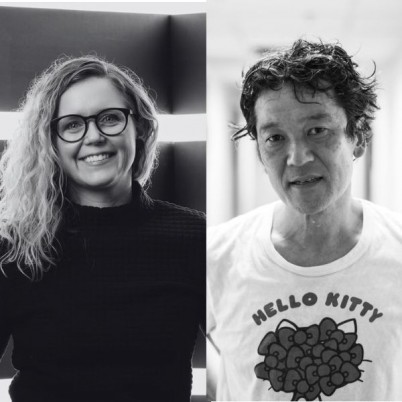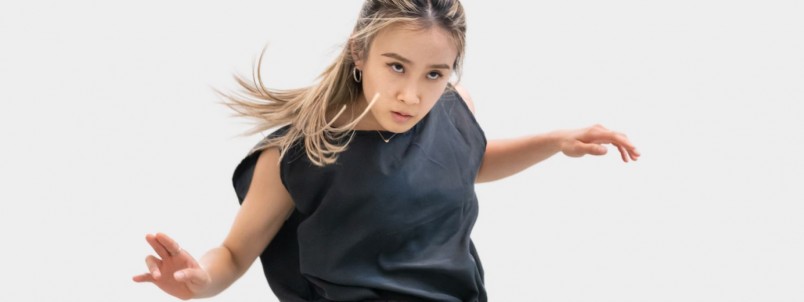
Tell us a little bit about the show, Thin Paper, Autonomous Synapses, Nomands, Tokyo(ing)!
Kota: Throughout the show, words float and scatter in the space, illuminating the image and concept of the work. The words are mainly collected and inspired by the scenery of Wellington and Tokyo. However, instead of creating a dance based on the image of the words, the show reveals a new sense of space and time while fusing different people, cultures, landscapes and moments. It becomes clear that the human body is extremely nervous and delicate. The joints are free, and any part of the body can be sent in a different direction, which makes me think that our movements are similar to that of a jellyfish.
Anita: Choreographically, this is a very busy show – you will probably miss moments because there is so much going on at the same time and that’s okay. I want to encourage audience members to relax; watch one dancer’s journey for a while, swap to somebody else, and then sit back and enjoy the overall picture. The movement is beautiful, the text poetic. Find something that resonates with you.
How do you think the show might make people feel? What emotions might it evoke or what thoughts do you think it might spark?
Anita: I think that the audience will echo the emotions that the dancers are feeling onstage. It may be a little overwhelming at times, but then you will sink into the flow and the poetry. There are lots of opportunities for people to see themselves reflected in the work, and maybe to see hints of Japanese culture as well.
Kota: By interjecting various emotions into the movement and words in the work, it may evoke many different images, thoughts or feelings for the audience. Ultimately, the show explores the schizophrenic and fluid nature of humans’ identities and presence, liberated from the socially pre-conditioned self and identity.
Anita, how did Footnote first end up connecting with Kota Yamazaki and what led to you collaborating again?
Anita: For our 2020-2021 season, Footnote was looking for an international choreographer to collaborate with. Among the pool of Japanese choreographers, Kota really stood out to us and led to him eventually choreographing a work on the company, which was part of the double-bill Undercurrent. After touring Aotearoa, we were supposed to take Undercurrent to Japan, but this trip was sadly cancelled due to COVID-19 and a film version was presented virtually instead.
So, for our 2024 programme, we wanted to explore this previous work of Kota’s and develop it into a full-length piece. We were also so excited to finally perform it live in Japan!

After performing in Japan, you must be excited for New Zealand audiences to also experience the work!
Anita: Yes, it was really exciting to see how audiences in Japan reacted to the work, and to start conversations with local people. Kota’s work is heavily influenced by his background in the traditional Japanese form of Butoh, which lends itself to making the work quite abstract and unique. We think it’s a very inspiring collaboration and are looking forward to sharing that with audiences in Aotearoa during Tempo Dance Festival.
Why do you think events like Tempo are important to have on the dance calendar?
Anita: Tempo is such an important opportunity for different dance forms to come together and festivals like this are a key to building audiences for dance. I might be biased, but this is especially critical for contemporary dance! We have an incredible art form that spans so many subgenres and styles. I believe there really is a contemporary dance style for everyone.
What has it been like bringing together your different cultures and backgrounds (Footnote from New Zealand and Kota from Japan).
Anita: It’s been amazing and very fulfilling! There have been quite a few moments of frustration in the rehearsal room due to the language barrier, but they are all followed by moments of “aha!”, and lots of laughter.
Something that is also quite different from how NZ choreographers usually work is that most of the movement in the show has come from Kota himself – almost none of it was made through prompts to the dancers. This has given the company an exciting challenge, and the movement style is different to things that are often made in Aotearoa.
Kota: Together with Footnote, I learned new things. I discovered a new dance language using both words and body. I realised it is very important to me to have elements of nature in my work, and also discovered a unique physicality of dance through the bodies of the Footnote dancers. This show is centred around the elements of these discoveries and I look forward to Aotearoa audiences experiencing these discoveries for themselves.

Production images: Naoshi Hatori, courtesy of Aichi Prefectural Art Theater | Rehearsal images: Stephen A'Court
Thin Paper, Autonomous Synapses, Nomads, Tokyo(ing) is on in Q Loft from 19 - 20 October. Click here to learn more and book your tickets.


